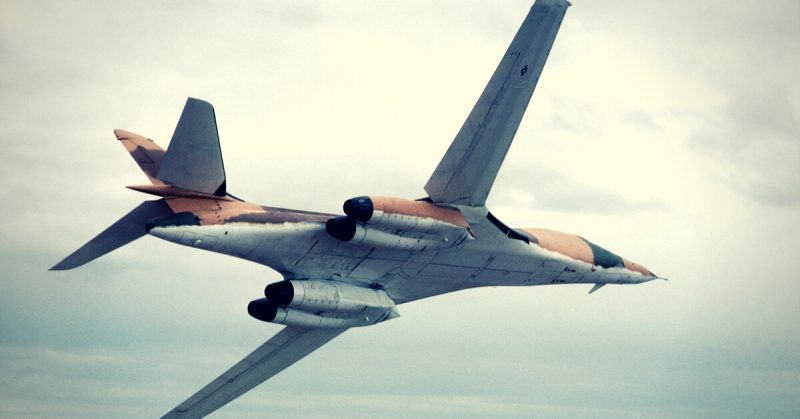The Cold War, that period of tension between the Western and Eastern world powers that lasted from the end of WWII until 1991, kept the world on tenterhooks about the possibility of a nuclear strike from one side or the other. The end of this unsettled period was brought about under the watch of President Ronald Reagan, and one of the major reasons for the collapse of the Cold War was the advent of the B-1 supersonic stealth bomber.
The program to replace the US Air Force’s aging fleet of B-52 Stratofortress bombers was started in 1970 under President Nixon. The general consensus amongst top military brass was that the Soviet Union held air superiority and could launch a first strike against the US and destroy the B-52’s on the ground. This was unacceptable, so Nixon launched a program to produce the B-1 bomber, a plane like no other seen in the world at that time.
With its variable swept wing design, its ability to evade radar, its top speed of 900 mph, its ability to carry 22 cruise missiles and its ability to climb to 10,000 feet in just under 2 minutes coupled with its ability to fly round trips of 11 hour duration, made this a plane to be feared by all the enemies of the western superpowers. This plane would give the US back its air superiority but due to budget cuts the program was scrapped in 1977 by President Carter but in 1981 Reagan resurrected the program after contracts to build components were shared amongst all the states.
The program at Rockwell was headed up by Sam Iacobellis who was the executive vice president and deputy chairperson at Rockwell. The program was the exception to the normal military contract in that Iacobellis brought it in under budget and ahead of schedule in only six years. The first B-1B was rolled off the production line and was delivered to Strategic Air Command in a little more than three and a half years and at the cost of $220 million.
So who was this man that had taken on the nay-sayers in the government and produced a strategic military weapon like no other seen in the world at that time and helped bring the Cold War to an end?

Sam Frank Iacobellis was born in Fresno, California on the 17th August 1929. His father, Frank Iacobellis, was a rancher and a first generation Italian immigrant while his mother, Mary Iacobellis (nee Ceppaglia) was a second generation Italian immigrant born in New York. Sam was raised and educated in Fresno where he attended California State University graduating with an engineering degree.
He took his master’s degree in engineering at the University of California in Los Angeles. His inspiration to go into aviation was a cousin that flew a P-51 Mustang during WWII, and when North American (later bought out by Rockwell) were recruiting on campus he applied and was employed as a draughtsman at a salary of $1.62 per hour!
In an interview he recalled those early days, “I didn’t ask how much they were going to pay me, I just wanted to go there. So the day after graduation I reported to Los Angeles to work.”
“It was one of the most rewarding experiences one could have because I was capitalizing on all the previous engineers’ work. I was taught to never take shortcuts because the life of a pilot or an astronaut or a crew member is in your hands.”
Rockwell was the only company that Sam Iacobellis ever worked for, and he retired after 43 years service. At the time of his retirement, he was one of the three operating officers responsible for rocket engines, aircraft and spacecraft operations.
Sam Iacobellis passed away at age 87, from complications arising from a stroke, in San Luis Obispo, California on 10th September 2016. He is survived by his wife, Helene, his son, Sam Iacobellis II, his daughter, Lee Ann Schantz, two grandchildren and his sister, Anna Saladino.
The Russian military told Robert Cattoi, a former chief engineer for Rockwell that the B-1B was a major reason or the collapse of the Cold War. In an interview with the Los Angeles Times, Mr. Cattoi said, “One of them asked me, ‘Do you know Sam Iacobellis? ‘If you see him, tell him he was far more responsible for ending the Cold War than he might realize. We didn’t have the resources to match it. It was the straw that broke the camel’s back.’”
After the Cold War Gen. Pyotr Deinekin, the former head of the Russian Air Force exchanged models of the B-1B and the Russian equivalent with Mr. Iacobellis. Gen. Deinekin included a note with his gift saying, “We both should be pleased that our airplanes did not have to see each other in combat.”
Sam Iacobellis was humble about the influence that he had had on world politics, saying, “We worked like we were on the front line of the Cold War.”
